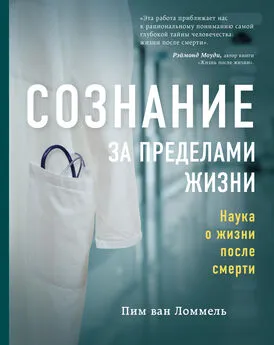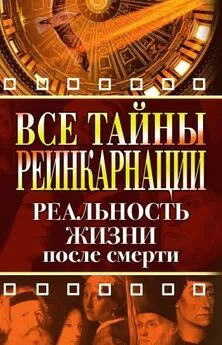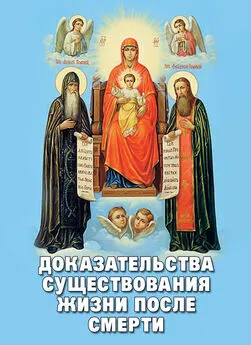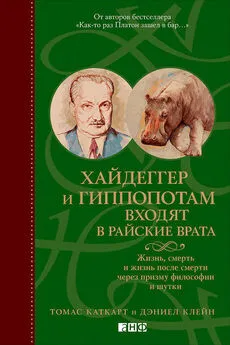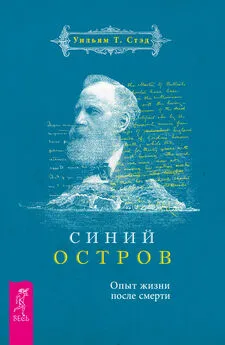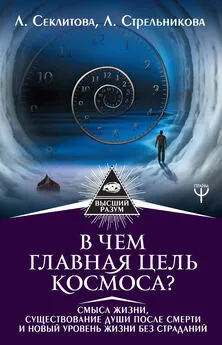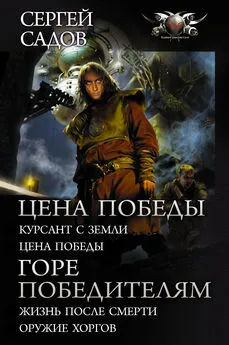Пим Ломмель - Сознание за пределами жизни. Наука о жизни после смерти
- Название:Сознание за пределами жизни. Наука о жизни после смерти
- Автор:
- Жанр:
- Издательство:Эксмо
- Год:2021
- Город:Москва
- ISBN:978-5-04-154586-4
- Рейтинг:
- Избранное:Добавить в избранное
-
Отзывы:
-
Ваша оценка:
Пим Ломмель - Сознание за пределами жизни. Наука о жизни после смерти краткое содержание
В формате PDF A4 сохранен издательский макет.
Сознание за пределами жизни. Наука о жизни после смерти - читать онлайн бесплатно ознакомительный отрывок
Интервал:
Закладка:
15. M. Hallett, “Transcranial Magnetic Stimulation and the Human Brain,” Nature 406 (2000): 147–150.
16. W. Penfield, The Excitable Cortex in Conscious Man (Liverpool: Liverpool University Press, 1958); O. Blanke et al., “Out-of-Body Experience and Autoscopy of Neurological Origin,” Brain 127 (2004): 243–258.
17. D. Liebetanz, “Pharmacological Approach to the Mechanisms of Transcranial DC-Stimulation-Induced After-Effects of Human Motor Cortex Excitability,” Brain 125 (2002): 2238–2247.
18. Глубокая стимуляция мозга (DBS) обладает и возбуждающим, и подавляющим эффектом, в зависимости от того, какое вещество мозга подвергается стимуляции – белое или серое.
19. H. S. Mayberg et al., “Deep Brain Stimulation for Treatment-Resistant Depression,” Neuron 45 (2005): 651–660; M. Hopkin, “Implant Boosts Activity in Injured Brain,” Nature 448 (2007): 522; N. D. Schiff et al., “Behavioural Improvements With Thalamic Stimulation After Severe Traumatic Brain Injury,” Nature 448 (2007): 600–603; M. N. Shadler and R. Kiani, “News and Views. Neurology: An Awakening,” Nature 448 (2007): 539–540.
20. M. Beauregard, “Mind Does Really Matter: Evidence from Neuroimaging Studies of Emotional Self-Regulation, Psychotherapy, and Placebo Effect,” Progress in Neurobiology 81, no. 4 (2007): 218–236.
21. M. Massimini et al., “Breakdown of Cortical Effective Connectivity During Sleep,” Science 309, no. 5744 (2005): 2228–2232.
22. Massimini et al., “Breakdown.”
23. N. S. White and M. T. Alkire, “Impaired Thalamocortical Connectivity in Humans During General-Anesthetic Induced Unconsciousness,” Neuroimage 19, no. 2, pt. 1 (2003): 401–411; M. T. Alkire and J. Miller, “General Anesthesia and the Neural Correlates of Consciousness,” Progress in Brain Research 150 (2005): 229–244; M. T. Alkire, A. G. Hudetz, and G. Tononi, “Consciousness and Anesthesia,” Science 322, no. 5903 (2008): 876–880.
24. T. J. Balkin et al., “The Process of Awakening: A PET Study of Regional Brain Activity Patterns Mediating the Re-establishment of Alertness and Consciousness,” Brain 125 (2002): 2308–2319.
25. J. A. Den Boer, Neuro-filosofie: Hersenen-Bewustzijn-Vrije wil [Нейрофилософия: мозг, сознание и свободная воля] (Amsterdam: Boom, 2003), 128.
26. S. Y. Berkovich, “On the Information Processing Capabilities of the Brain: Shifting the Paradigm,” Nanobiology 2 (1993): 99–107; H. Romijn, “Are Virtual Photons the Elementary Carriers of Consciousness?” Journal of Consciousness Studies 9 (2002): 61–81.
27. K. Pribram, “The Neurophysiology of Remembering,” Scientific American 220 (1969): 75; K. Lashley, “In Search of the Engram,” Psychological Mechanisms in Animal Behavior (New York: Academic Press, 1950), 454–482.
28. R. Lewin, “Is Your Brain Really Necessary?” Science 210 (1980): 1232–1234.
29. M. Nahm and B. Greyson, “Terminal Lucidity in Patients with Chronic Schizophrenia and Dementia: A Survey of the Literature,” Journal of Nervous and Mental Disease 197, no. 12 (2009): 942–944.
30. Schwartz, and Begley, Mind and the Brain .
31. N. Doidge, The Brain That Changes Itself: Stories of Personal Triumph from the Frontiers of Brain Science (London: Penguin Books, 2007).
32. P. R. Huttenlocher, “Synapse Elimination and Plasticity in Developing Human Cerebral Cortex,” American Journal of Mental Deficiency 88 (1984): 488–496.
33. M. T. Acosta, P. Montanez, and F. E. Leon-Sarmiento, “Half Brain but Not Half Function,” Lancet 360 (2002): 643; J. Borgstein and C. Grootendorst, “Clinical Picture: Half a Brain,” Lancet 359 (2002): 473.
34. H. S. Mayberg et al., “The Functional Neuroanatomy of the Placebo Effect,” American Journal of Psychiatry 159 (2002): 728–737.
35. T. D. Wager, “Placebo-Induced Changes in fMRI in the Anticipation and Experience of Pain,” Science 303 (2004): 1162–1167; F. Benedetti et al., “Neurobiological Mechanisms of the Placebo Effect,” Journal of Neuroscience 25, no. 45 (2005): 10390–10402.
36. Beauregard, M. “Mind Does Really Matter: Evidence from Neuroimaging Studies of Emotional Self-Regulation, Psychotherapy, and Placebo Effect.” Progress in Neurobiology 81, no. 4 (2007): 218–236; M. Beauregard and D. O’Leary, “Toward a Nonmaterialistic Science of Mind,” chap. 6, в кн: The Spiritual Brain: How Neuroscience Is Revealing the Existence of the Soul (San Francisco: HarperOne, 2007), 125–180.
37. Schwartz and Begley, Mind and the Brain ; R. J. Davidson et al., “Alterations in Brain and Immune Function Produced by Mindfulness Meditation,” Psychosomatic Medicine 65, no. 4 (2003): 564–570.
38. На ЭЭГ фиксируются различные мозговые волны, перечисленные в порядке роста их частоты: дельта, тэта, альфа, бета и гамма-волны. У дельта-волн наиболее низкая частота. Считается, что тэта-волны соответствуют состоянию расслабления, медитации и творчества, а гамма-волны обычно ассоциируются с пиковой концентрацией, оптимальным когнитивным функционированием, ростом умственных способностей и повышением уровня сострадания и счастья. См. A. Lutz et al., “Long-Term Meditators Self-Induce High-Amplitude Gamma Synchrony During Mental Practice,” Proceedings of the National Academy of Science, USA 101, no. 46 (2004): 16369–16373.
39. M. Baringa, “Buddhism and Neuroscience: Studying the Well-Trained Mind,” Science 302 (2003): 44–46; M. Beauregard and V. Paquette, “Neural Correlates of a Mystical Experience in Carmelite Nuns,” Neuroscience Letters 405 (2006): 186–190.
40. При таком рассечении ткани мозолистого тела, соединяющие два полушария головного мозга и способствующие связи и координации действий между ними, частично разделяют.
41. R. W. Sperry, “Mental Phenomena as Causal Determinants in Brain Function,” в кн.: Consciousness of the Brain , ed. G. G. Globus, G. Maxwell, and I. Savodnik (New York: Plenum, 1976); B. Libet et al., “Time of Conscious Intention to Act in Relation to Onset of Cerebral Activity (Readiness Potential): The Unconscious Initiation of a Freely Voluntary Act,” Brain 106 (1983): 623–642; B. Libet, “A Testable Field Theory of Mind-Brain Interaction,” Journal of Consciousness Studies 1 (1994): 119–126; B. Libet, Mind Time: The Temporal Factor in Consciousness (Cambridge, MA: Harvard University Press, 2004); M. Beauregard, P. Lévesque, and V. Paquette, “Neural Basis of Conscious and Voluntary Self-Regulation of Emotion,” в кн.: Consciousness, Emotional Self-Regulation and the Brain , ed. M. Beauregard (Amsterdam: John Benjamins Publishing, 2004), 163–194.
42. D. Dennett, Consciousness Explained (Boston and London: Little, Brown, 1991); S. J. Blackmore, “There Is No Stream of Consciousness,” Journal of Consciousness Studies 9, nos. 5–6 (2002): 17–28.
43. R. Penrose, Shadows of the Mind (Oxford: Oxford University Press, 1996); Beauregard and O’Leary, Spiritual Brain ; Noë, Out of Our Heads .
1. S. Hawking, The Universe in a Nutshell (London: Bantam Press, 2001).
2. M. Bischof, Biophotonen – Das Licht, das unsere Zellen steuert [Биофотоны – свет, управляющий нашими клетками], 11 thed. (Frankfurt: Verlag Zweitausendeins, 2001), 217. Сайт http://www.marcobischof.com содержит ряд статей на английском, посвященных тому же предмету.
3. N. J. Nersessian, “Aether Or: The Creation of Scientific Concepts,” Studies in the History and Philosophy of Science 15 (1984): 175–212.
4. F. Rutherford, G. Holton, and F. G. Watson, “Unit 4 Light and Electromagnetism,” chap. 13, в кн.: Project Physics Course (New York: Holt, Reinhart& Winston, 1968), 14.
5. N. Bohr and J. Kalckar, eds., Collected Works , vol. 6, Foundations of Quantum Physics I (1926–1932) (Amsterdam and New York: North Holland, 1997), 91–94; B. Rosenblum and F. Kuttner, “The Observer in the Quantum Experiment,” Foundations of Physics 32, no. 8 (2002): 1273–1293; N. Bohr, Atomic Physics and Human Knowledge (New York: Wiley, 1958), 81; N. Bohr, Essays 1958–1962 on Atomic Physics and Human Knowledge (New York: Wiley, 1963), 15.
6. M. Born, My Life and My Views: A Nobel Prize Winner in Physics Writes Provocatively on a Wide Range of Subjects (New York: Scribner, 1968), 48.
7. E. Schrödinger, “Discussion of Probability Relations Between Separated Systems,” Cambridge Philosophical Society Proceedings 32 (1935): 555.
8. W. Heisenberg, Physics and Beyond (New York: Harper & Row, 1971); R. Penrose, Shadows of the Mind: A Search for the Missing Science of Consciousness (Oxford: Oxford University Press, 1996).
9. J. von Neumann, The Mathematical Foundations of Quantum Mechanics (Princeton: Princeton University Press, 1955), цит. по: A. Goswami, R. E. Reed, and M. Goswami, The Self-Aware Universe: How Consciousness Creates the Material World (New York: Jeremy Tarcher/Putman, 1993).
10. H. Stapp, Mind, Matter and Quantum Mechanics , 2 nded. (Berlin and Heidelberg: Springer Verlag, 2004); E. Wigner, “The Problem of Measurement,” Journal of Physics 31, no. 6 (1963); R. Nadeau and M. Kafatos, The Non-Local Universe: The New Physics and Matters of the Mind (New York: Oxford University Press, 1999); Goswami, Reed, and Goswami, Self-Aware Universe ; F. A. Wolf, The Spiritual Universe: One Physicist’s Vision of Spirit, Soul, Matter and Self (Portsmouth, NH: Moment Point Press, 1996).
11. A. Aspect, J. Dalibard, and G. Roger, “Experimental Tests of Bell’s Inequality Using Varying Analyses,” Physical Review Letters 25 (1982): 1084.
12. I. Marcikic et al., “Distribution of Time-Bin Entangled Qubits over 50 km of Optical Fiber,” Physical Review Letters 93, no. 18 (2004): 180502–1–4; D. Greenberger, M. Horne, and A. Zeilinger, “Going Beyond Bell’s Theorem,” в кн.: Bell’s Theorem, Quantum Theory, and Conceptions of the Universe, ed. M. Kafatos (Dordrecht, the Netherlands: Kluwer Academics, 1989), 73–76.
13. F. A. Wolf, Taking the Quantum Leap: The New Physics For Non-scientists (New York: Harper & Row, 1989), chap. 5, pp. 87–93.
14. A. Einstein, “The Concept of Space,” Nature 125 (1930): 897–898; W. J. Moore, Schrödinger: Life and Thought (Cambridge and New York: Cambridge University Press, 1989); K. C. Cole, “In Patterns, Not Particles, Physics Trust,” Los Angeles Times , March 4, 1999.
Читать дальшеИнтервал:
Закладка:
